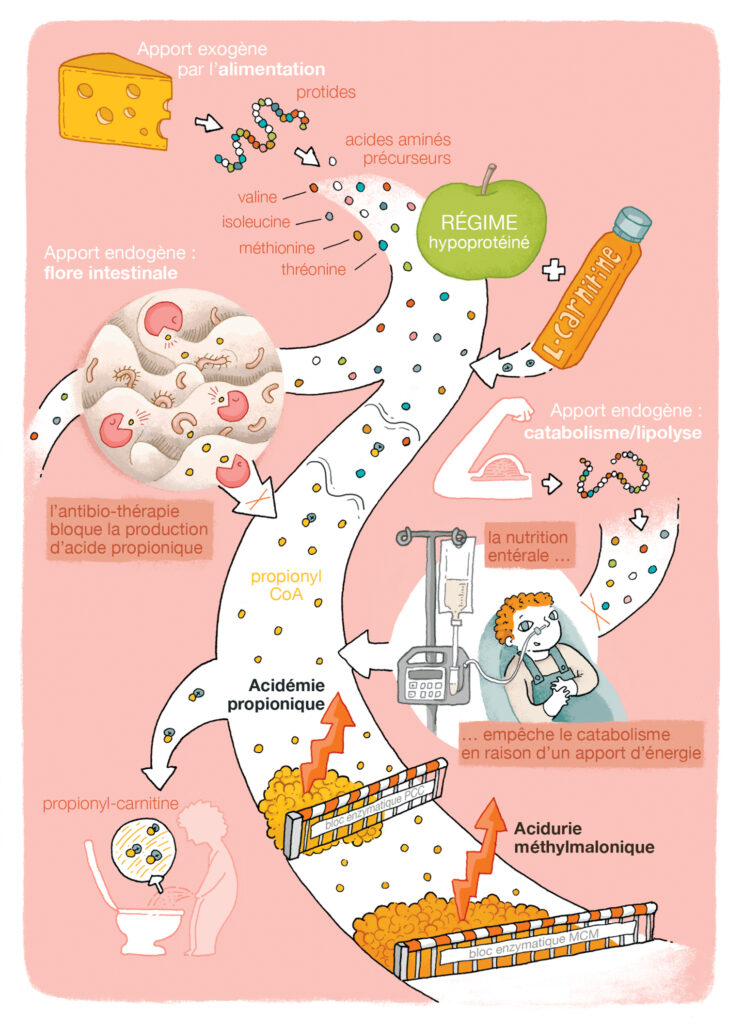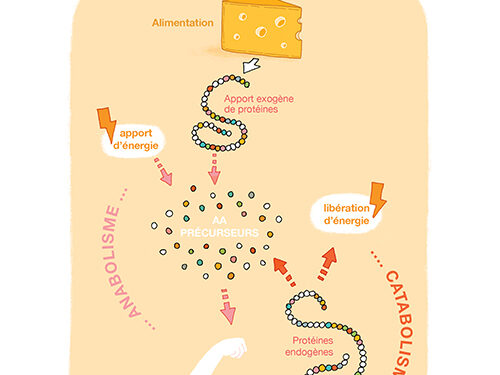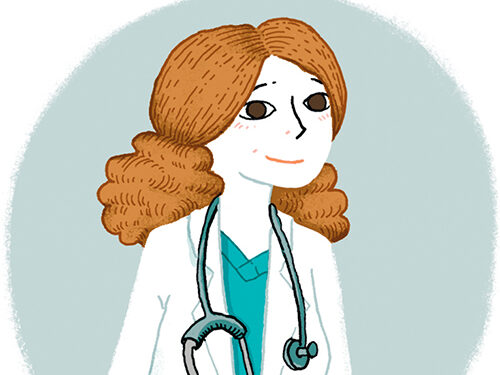The normal diet
Our body is made up of 5 main elements: water, proteins, fats, minerals, carbohydrates and vitamins which play an essential role. We need all these elements to live. They are mainly provided by food.
DIGESTION
When we eat, food is digested, i.e. gradually transformed and reduced into substances that can be absorbed and used by the cells of our body: these are the nutrientsA nutrient is a substance provided by food that ensures the development and maintenance of the body. Proteins, carbohydrates, fats, vitamins, minerals and trace elements are nutrients..
Certain nutrientsA nutrient is a substance provided by food that ensures the development and maintenance of the body. Proteins, carbohydrates, fats, vitamins, minerals and trace elements are nutrients. will produce energy, which is essential for all vital functions. These are: sugars (or carbohydrates) and fats (or lipids).
Proteins (protides) are mainly involved in tissue synthesis (growth), maintenance and renewal. “Excess protein can be broken down to produce energy. Other nutrientsA nutrient is a substance provided by food that ensures the development and maintenance of the body. Proteins, carbohydrates, fats, vitamins, minerals and trace elements are nutrients. do not provide energy but are essential to our body: these are water, mineralsA mineral is an inorganic substance present in the human body.
Whether naturally formed or not, the mineral is defined by its chemical composition and the arrangement of its atoms. The term mineral is used when the body of a man weighing 70 kg contains more than 5 g of the element. The main minerals are: calcium, sodium, magnesium, phosphorus, and potassium. and vitamins.


What is metabolism?
It is the set of chemical transformations of nutrientsA nutrient is a substance provided by food that ensures the development and maintenance of the body. Proteins, carbohydrates, fats, vitamins, minerals and trace elements are nutrients., which are necessary to produce energy and synthesise the body’s components. These chemical reactions are carried out by enzymes (a kind of “tool”). There are many different enzymes, one for each chemical reaction. The normal functioning of an enzymeAn enzyme is a protein (or in certain cases an RNA) which catalyses (speeds up) a metabolic reaction. consumes energy, and sometimes requires the presence of a cofactorAs its name indicates, a cofactor intervenes with other molecules (proteins, vitamins, etc.) during a reaction. Its presence may be essential for the process to run smoothly. (a substance that increases the functioning of the enzymeAn enzyme is a protein (or in certain cases an RNA) which catalyses (speeds up) a metabolic reaction. and is often a vitamin).
Protein metabolism
Proteins are made up of amino acids (like links in a chain). There are 20 different amino acids that make up the proteins of the human body. Some of these amino acids must be provided by the diet (essential amino acids), as the human body is unable to produce them. Proteins differ in their composition, i.e. the length of the chain and the order in which the amino acids are assembled.
Origin of amino acids in the blood
Most foods contain proteins. The digestion of proteins will result in the release of amino acids into the bloodstream (fig. 1). Amino acids circulating in the blood also come from the breakdown of proteins in the body, which must be constantly renewed when they are “used up”. Amino acids therefore have two origins, one exogenous (food) and the other endogenous (breakdown of body proteins).
Synthesis of the body’s proteins
Amino acids circulating in the blood (precursor amino acids) are mainly used for the synthesis of body proteins, also known as “anabolism”. This synthesis (which consumes energy) is essential for the growth and renewal of the body’s proteins.
Amino acid catabolism
Our daily diet is often “too rich” in protein and far exceeds the amino acidAmino acids are molecules that combine to form proteins. 20 amino acids make up the proteins of the human body. Of these, 8 are essential (our body cannot synthesise them, they must be supplied by the diet): isoleucine, leucine, lysine, methionine, phenylalanine, threonine, tryptophan, valine.
Arginine and histidine are semi-indispensable. In fact, only infants need to take them from their food.
Cysteine, glycine and tyrosine may be indispensable for certain populations requirements for protein synthesis in the body. The “excess” amino acids are broken down to produce some energy. This is known as the “catabolism” of amino acids. This catabolism requires the intervention of different enzymes, usually with a specific enzymeAn enzyme is a protein (or in certain cases an RNA) which catalyses (speeds up) a metabolic reaction. for each amino acidAmino acids are molecules that combine to form proteins. 20 amino acids make up the proteins of the human body. Of these, 8 are essential (our body cannot synthesise them, they must be supplied by the diet): isoleucine, leucine, lysine, methionine, phenylalanine, threonine, tryptophan, valine.
Arginine and histidine are semi-indispensable. In fact, only infants need to take them from their food.
Cysteine, glycine and tyrosine may be indispensable for certain populations, sometimes for a few amino acids. The intermediate products of the degradation of each amino acidAmino acids are molecules that combine to form proteins. 20 amino acids make up the proteins of the human body. Of these, 8 are essential (our body cannot synthesise them, they must be supplied by the diet): isoleucine, leucine, lysine, methionine, phenylalanine, threonine, tryptophan, valine.
Arginine and histidine are semi-indispensable. In fact, only infants need to take them from their food.
Cysteine, glycine and tyrosine may be indispensable for certain populations are organic acids, the degradation of which will ultimately produce some energy.

More information on your treatment guide

Arginine and histidine are semi-indispensable. In fact, only infants need to take them from their food.
Cysteine, glycine and tyrosine may be indispensable for certain populations catabolism



